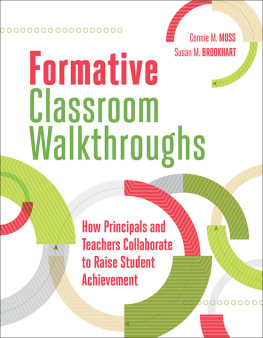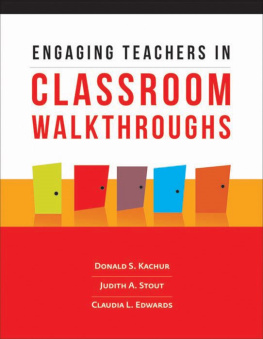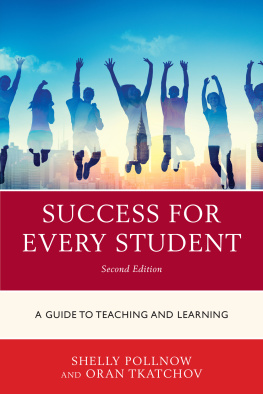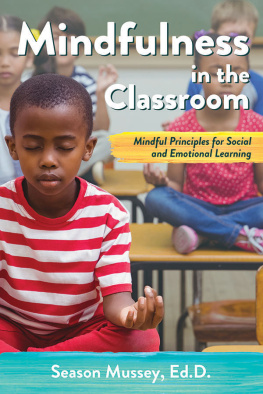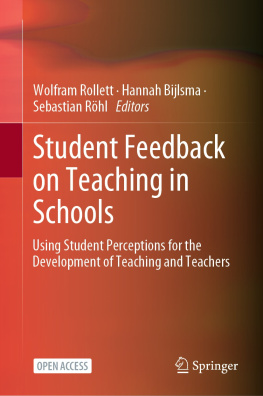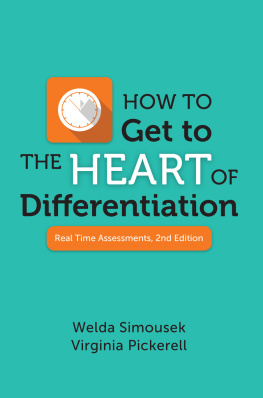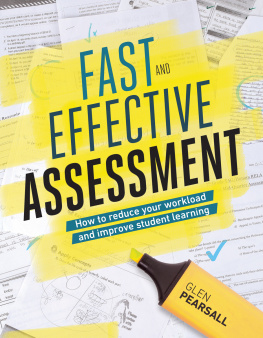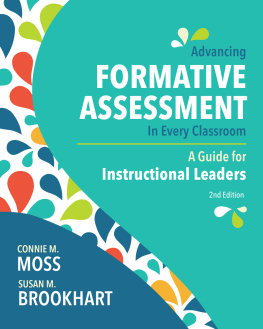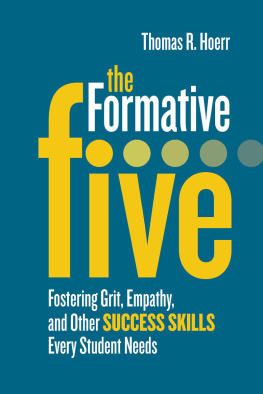Connie M. Moss - Formative Classroom Walkthroughs: How Principals and Teachers Collaborate to Raise Student Achievement
Here you can read online Connie M. Moss - Formative Classroom Walkthroughs: How Principals and Teachers Collaborate to Raise Student Achievement full text of the book (entire story) in english for free. Download pdf and epub, get meaning, cover and reviews about this ebook. year: 2015, publisher: ASCD, genre: Children. Description of the work, (preface) as well as reviews are available. Best literature library LitArk.com created for fans of good reading and offers a wide selection of genres:
Romance novel
Science fiction
Adventure
Detective
Science
History
Home and family
Prose
Art
Politics
Computer
Non-fiction
Religion
Business
Children
Humor
Choose a favorite category and find really read worthwhile books. Enjoy immersion in the world of imagination, feel the emotions of the characters or learn something new for yourself, make an fascinating discovery.
- Book:Formative Classroom Walkthroughs: How Principals and Teachers Collaborate to Raise Student Achievement
- Author:
- Publisher:ASCD
- Genre:
- Year:2015
- Rating:3 / 5
- Favourites:Add to favourites
- Your mark:
- 60
- 1
- 2
- 3
- 4
- 5
Formative Classroom Walkthroughs: How Principals and Teachers Collaborate to Raise Student Achievement: summary, description and annotation
We offer to read an annotation, description, summary or preface (depends on what the author of the book "Formative Classroom Walkthroughs: How Principals and Teachers Collaborate to Raise Student Achievement" wrote himself). If you haven't found the necessary information about the book — write in the comments, we will try to find it.
Connie M. Moss: author's other books
Who wrote Formative Classroom Walkthroughs: How Principals and Teachers Collaborate to Raise Student Achievement? Find out the surname, the name of the author of the book and a list of all author's works by series.
Formative Classroom Walkthroughs: How Principals and Teachers Collaborate to Raise Student Achievement — read online for free the complete book (whole text) full work
Below is the text of the book, divided by pages. System saving the place of the last page read, allows you to conveniently read the book "Formative Classroom Walkthroughs: How Principals and Teachers Collaborate to Raise Student Achievement" online for free, without having to search again every time where you left off. Put a bookmark, and you can go to the page where you finished reading at any time.
Font size:
Interval:
Bookmark:


....................
We are deeply thankful for our great, good fortune to be married to wonderful husbands and to be loved by remarkable daughters.
Connie thanks her husband John Moss and her daughter Rachael Moss. The depth of your love and the balance of a happy life are the sources of my strength.
Sue thanks her husband Frank Brookhart and her daughters Carol Brookhart and Rachel Brookhart. Your love and support sustains me and inspires me.
....................
Without the significant contributions of countless educators, this bookenriched by their classroom examples and insightful commentscould certainly not exist. Thank you for welcoming us into your lessons, classrooms, schools, and districts. We are fortunate that our collaborative relationships produced so many crucial conversations, shared examples, critical questions, and models of success. To each of these wonderful people, we express our sincere hope that this book captures the best of what you accomplish daily as you help students aim for understanding in each lesson. We are particularly indebted to the following educators, presented here by district in alphabetical order.
We are grateful to the Armstrong School District for our 16-year partnership. We especially thank Dr. Shauna Braun-Zukowski, Tom Dinga, Kirk Lorigan, Michael Cominos, James Rummel, Dr. Stephen Shutters, Dr. Cheryl Soloski, Paula Berry, Brian Thimons, Jennifer Reiter, Paula Kijowski, Chuck Kreinbucher, Dr. Stan Chapp, Dr. Michael Glew, Dr. Matthew Pawk, Courtney Shephard, and Annie Barnett.
We thank the administrators, teachers, and instructional coaches of the Erie City Public Schools. We extend special thanks to Dr. Jay D. Badams, Nancy J. Sadaly, Dana Suppa, Sherry Prater, Barb Zimmer, Karin Ryan, Fay Nelson, Holly Northrup, Matthew Parker, Dana Gilmore, John Wasiulewski, Fabienne Mir, Richard Gudowski, Diane Madara, Jeff Boam, Joseph Orlando, Robert Causgrove, Carla Johnson, Colleen Holmes, Diane Sutton, Gina Rullo, Donald Orlando, Ina Fisher, Pat Babay, Gretchen Thomas, and Rachel Morey.
We are grateful to the administrators and teachers of the Lakeview School District, especially Doug Mays, Jen Johnston, Tim Eiler, Carol Lilly, Jason Sample, Issac Gadsby, Melissa Johnson, and David Blakely.
We sincerely appreciate our collaboration with the administrators and teachers in the Laurel School District, and especially thank Dr. Sandra Hennon, Dr. Susan Miller, Kevin Mahoney, and Angela Traggiai.
We are particularly thankful for our partnership with the administrators and teachers of the Norwin School District, and express our sincere gratitude to Dr. William H. Kerr, Dr. Tracy McNelly, Natalie McCracken, Heather Newell, Michael Choby, Joseph V. Shigle, Robert Suman, Brian O'Neil, Lisa A. Banasick, Lisa Willig, Doreen Harris, Denise Ebbitt, Connie DeMore, Lynn Schmook, Doug Aftanas, Nicole Stoops, Julia Woitkowiak, Dana Helphenstein, Timothy J. Kotch, and Jason Cendroski.
We sincerely appreciate the opportunity to have learning target conversations "on the road," and we express our gratitude to the Clever R-V Public Schools in Clever, Missouri, and the Provo City School District in Provo, Utah, for their great questions.
We acknowledge our colleagues in the Duquesne University School of Education, especially Fr. Naos McCool, C.S.Sp., Assistant Dean for Formation and express our admiration for our friends in the Department of Foundations and Leadership who unfailingly work across boundaries as they aspire for social justice.
We extend special appreciation to ASCD. We are deeply thankful for the editorial brilliance of Genny Ostertag who believed in our work from the first moment she heard of it. To our project manager, Darcie Russell, thank you for your sense of humor, willingness to work through challenging deadlines, and commitment to getting each part of this book right.
And finally, we are indebted to our dear colleague, the incomparable Dr. Beverly A. Long whose invitation was the catalyst all those years ago and whose friendship we treasure.
Chapter 1
....................
The complexities of teaching and learning in 21st century schools require educators who meet those challenges by continually evaluating evidence and exercising trustworthy judgment. On a daily basis, they must continue to learn about effective educational practices and to weigh the effectiveness of their own classroom practices. Without both perspectives, educators are hard pressed to deepen their understanding about their students and use that evidence to exercise sound professional judgment. To make good decisions, educators must keep what is best for their students at the heart of their decision making.
Toward this end, many principals, curriculum directors, coaches, and teachers are using a new view of classroom walkthroughsformative rather than evaluativethat helps them to gather real-time evidence to guide their decisions, cultivate schoolwide improvement efforts, and sustain meaningful professional development. Supported by years of research on effective professional learning (Darling-Hammond & McLaughlin, 1995), formative walkthroughs help educators engage each other in directly confronting research and theory to regularly evaluate their own practices in a safe culture characterized by mutual assistance and sustained through coaching and collaborative problem solving around specific problems of practice (Moss & Brookhart, 2014).
We wrote this book to help educators engage in the formative walkthrough process to harness the power of collaborative inquiry and evidence-based decision making. In it we employ a learning target theory of action (Moss, Brookhart, & Long, 2013) grounded in the belief that improving student learning and teacher quality happens in the immediacy of daily lessons or it doesn't happen at all. Through our extensive work with teachers and administrators in schools and districts, we have found that the same learning target theory of action that has helped thousands of educators increase student learning holds particular promise for coaching and supporting educational professionals at all levels of practice.
Simply stated, the goal of a collaborative learning culture is to build communities of teachers who continuously engage in the study of their craft; develop the shared language and common understandings necessary to pursue collegial study of new knowledge and skills; and provide structure for follow-up and follow-through (Showers, 1985). Formative walkthroughs promote these actions when they are paired with collaborative feedback, used in the context of professional learning targets, and focused on both professional learning and student learning. Formative walkthroughs are about the learning of all parties within the school: administrators, teachers, and students. In a collaborative culture, feedback typically takes the form of professional conversations, and follow-through looks at evidence of both teaching improvements and student achievement. Good coaching that includes formative feedback can be instrumental in helping educators better understand the need for evidence-based change and improvement in their practice (Puig & Froelich, 2006).
A collaborative learning culture integrates newly acquired professional knowledge with the daily work of teachers, promotes collective participation, aligns with instructional goals and practices, links to national and local standards, and provides opportunities for active participation and learning (Garet, Porter, Desimone, Birman, & Yoon, 2001). A culture of evidence-based learning and decision making raises the quality of teaching and learning in every classroom as a public process of collaborative inquiry. This process requires instructional planning that digs deeply into content and fosters conversations and questions about improving student learning that are continuous, evidence-based, and "nondefensive" (Saphier & West, 2010, p. 46). Following this logic, then, the best collaborative learning is "nonthreatening and supportive" and helps educators continuously enact their new learning to see it work with students (Poglinco et al., 2003).
Font size:
Interval:
Bookmark:
Similar books «Formative Classroom Walkthroughs: How Principals and Teachers Collaborate to Raise Student Achievement»
Look at similar books to Formative Classroom Walkthroughs: How Principals and Teachers Collaborate to Raise Student Achievement. We have selected literature similar in name and meaning in the hope of providing readers with more options to find new, interesting, not yet read works.
Discussion, reviews of the book Formative Classroom Walkthroughs: How Principals and Teachers Collaborate to Raise Student Achievement and just readers' own opinions. Leave your comments, write what you think about the work, its meaning or the main characters. Specify what exactly you liked and what you didn't like, and why you think so.

